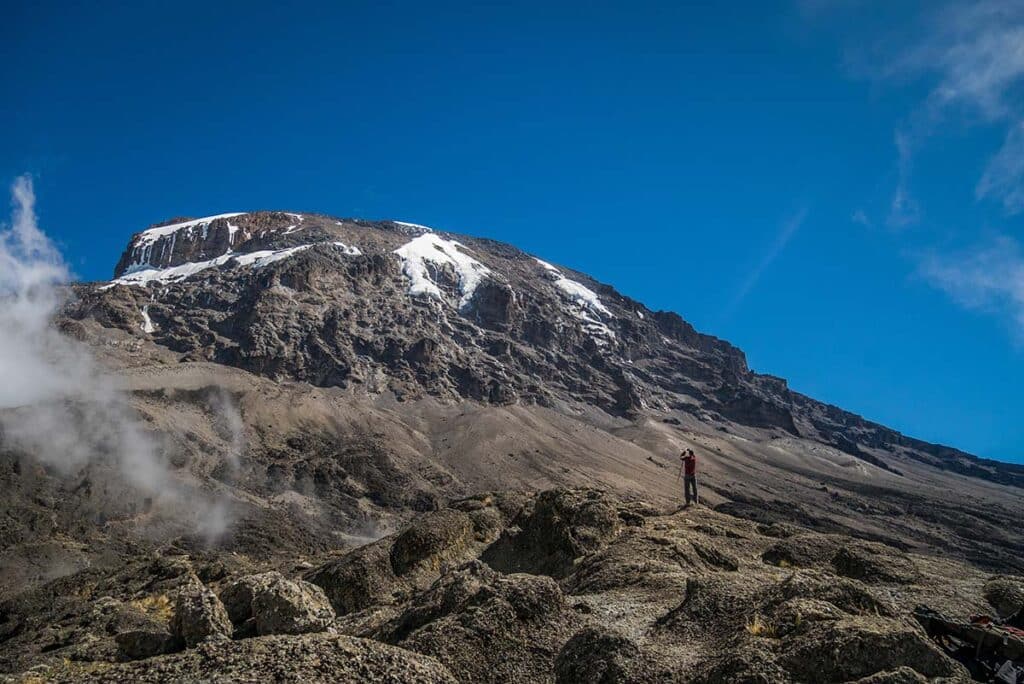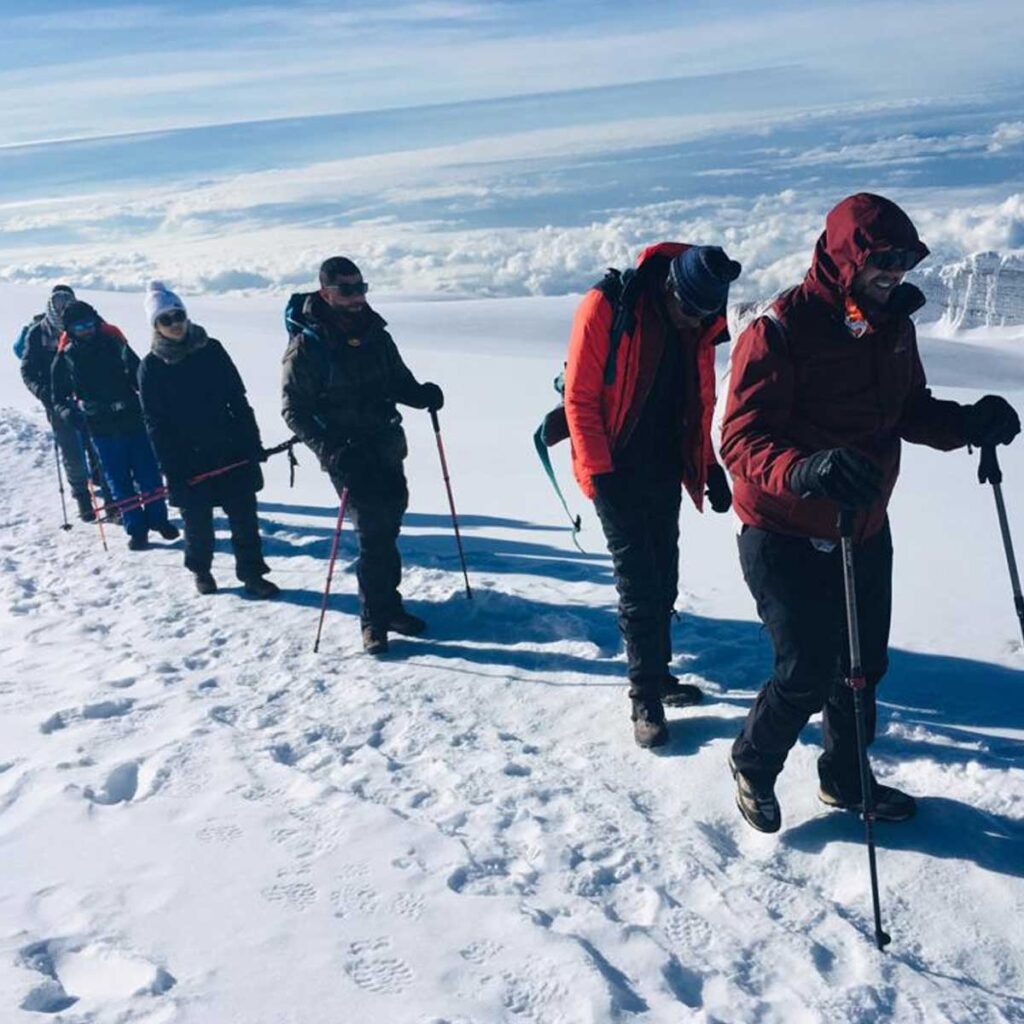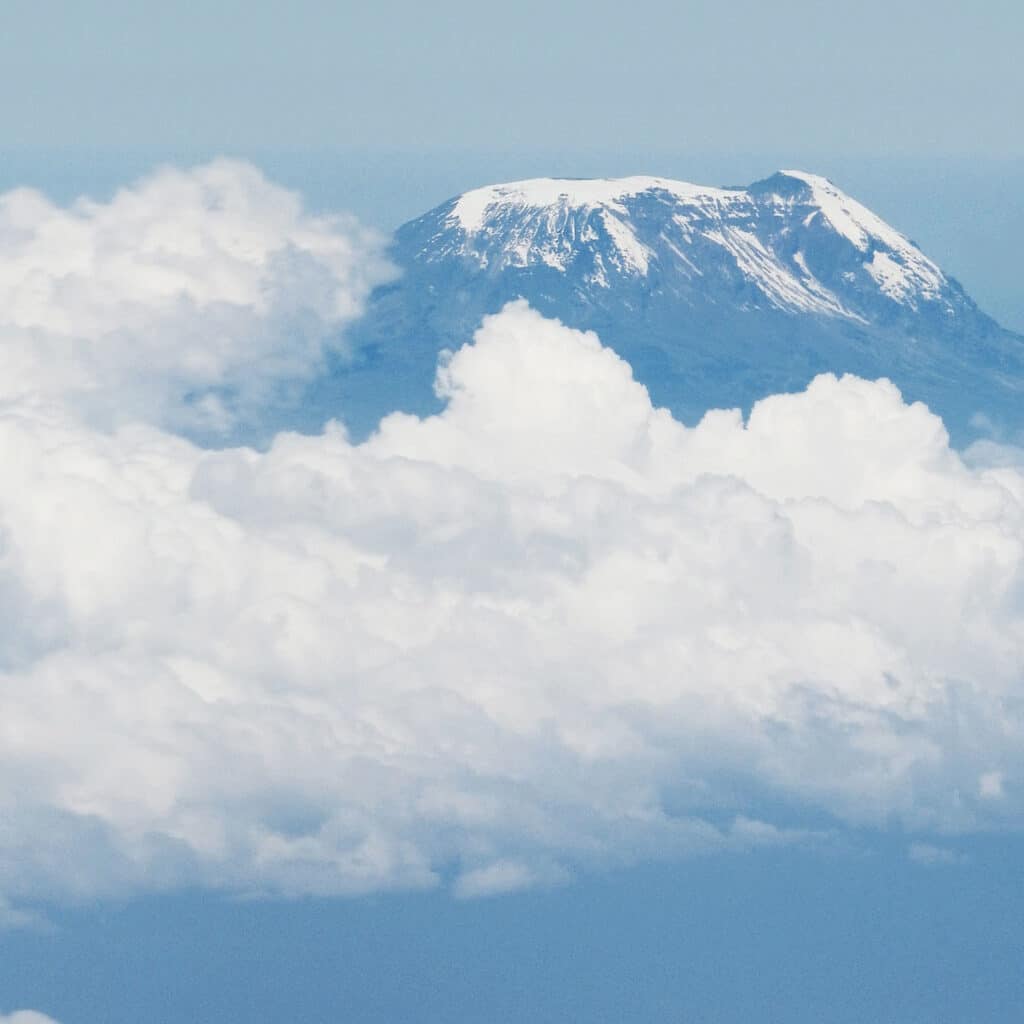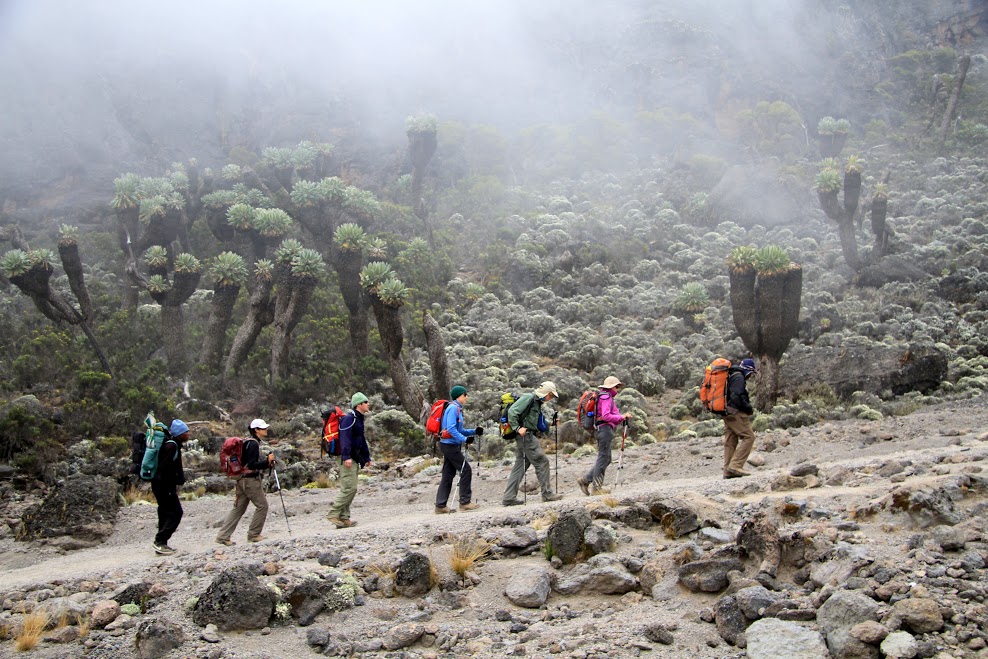Home » Mount Kilimanjaro Trekking
Difficult
5 - 11 days
19,341 ft
18 to 55 years
Kilimanjaro needs no introduction. Mount Kilimanjaro Trekking offers the unparalleled experience of standing atop the world’s highest free-standing mountain.
At Great Image Expedition, we guide you to the summit via the Machame route. This path combines adventure with strikingly diverse scenery.
Over six days, the landscape transforms dramatically. On Day 1, you gaze at the mountain rising from the plains. As you trek, you move through cultivated fields, dense rainforests, and moorlands and suddenly find yourself in alpine deserts filled with rock and scree. Beyond that, you encounter arctic snowfields and glaciers—a breathtaking journey.
This trek immerses you in the rich local Tanzanian culture, enhancing the hike experience. Our local partners, residents of the villages surrounding Kilimanjaro, will share stories, traditions, and regional cuisine with you.
“This trek is essential not just for experiencing Kilimanjaro but also for the African wilderness and culture,” says Arjun Majumdar, “Before and after the trek, explore the unique wildlife landscapes of the Serengeti National Park and the Ngorongoro Crater. If you have time, visit some historic towns and enjoy Tanzania’s crystal-clear beaches,”
The best part is that Kilimanjaro is one of the Seven Summits that doesn’t require technical climbing skills or mountaineering experience. However, it is a challenging endeavour. Climbing to 19,341 feet and trekking 60 km over six days demands excellent physical fitness.
We believe trekkers must be well informed before embarking on a high-altitude trek. Knowledge can mean the difference between a safe and a hazardous trek and distinguish a fulfilling experience from a superficial one.
In this section, you’ll find comprehensive information about the Mount Kilimanjaro Trekking. It covers each day’s details, what to expect, and how to prepare. This content is built on years of expertise and has proven extremely useful to trekkers.
The difficulty of the Mount Kilimanjaro Trekking varies depending on several factors, including the route chosen, the trekker’s physical fitness, altitude acclimatization, and weather conditions. Here’s a breakdown of these factors:
Mount Kilimanjaro Trekking offers several routes, each with varying levels of difficulty:
Mount Kilimanjaro Trekking requires a good level of physical fitness. While no technical climbing skills are needed, the trek involves long days of hiking, often for 6-8 hours, and a significant elevation gain. Cardiovascular endurance, strength, and stamina are essential.
Altitude is one of the most significant challenges of the Mount Kilimanjaro Trekking. The summit, Uhuru Peak, stands at 5,895 meters (19,341 feet). Altitude sickness can affect anyone regardless of fitness level. Routes that offer gradual ascents and extra acclimatization days, like Lemosho or Northern Circuit, help improve the chances of reaching the summit without severe altitude sickness.
Weather on Kilimanjaro can be unpredictable and varies with altitude. Trekkers experience different climate zones, from tropical forest at the base to arctic conditions at the summit. Being prepared for extreme cold, rain, and wind is crucial.
The psychological aspect is often underestimated. Long days of trekking, coupled with the effects of altitude and potential discomfort from the weather, require mental resilience. The summit night is particularly challenging, involving a midnight start to reach the peak at sunrise.
Overall, the Mount Kilimanjaro Trekking is challenging but achievable for most people with adequate preparation. Choosing the right route, improving physical fitness, allowing for proper acclimatization, and preparing mentally for the trek are key to a successful ascent. While it’s not a technical climb, it demands determination, preparation, and respect for the mountain’s condition
Climbing Mount Kilimanjaro is a remarkable adventure, and choosing the best time to embark on this trek can significantly enhance your experience. Here’s a detailed explanation of the optimal times for Mount Kilimanjaro Trekking, based on weather conditions and other factors:
January to March
June to October
November
April to May
For the best experience, the prime times for Mount Kilimanjaro Trekking are from January to March and from June to October. These periods offer the most favorable weather conditions, ensuring a safer and more enjoyable trek. However, if you seek a quieter adventure and are prepared for more challenging conditions, the shoulder seasons of November and April-May can provide a unique and rewarding experience.
Reaching the base camp, whether it’s for Mount Kilimanjaro Trekking or another major expedition, involves several key steps that include preparation, travel, and trekking. Here is a general outline of the process:
Packing for Mount Kilimanjaro Trekking requires careful consideration to ensure you have everything you need while keeping your load manageable. Here’s a comprehensive guide to what you should pack for your trekking adventure:
By carefully considering these items and tailoring your pack to the specific conditions and length of your trek, you’ll be well-prepared for a safe and enjoyable adventure.
Mount Kilimanjaro Trekking is an incredible adventure, but it’s also a significant physical challenge. Here are several reasons why getting fit for this trek is crucial:
Mount Kilimanjaro stands at 5,895 meters (19,341 feet), making it the highest peak in Africa. At such high altitudes, the air is thinner and contains less oxygen, which can lead to altitude sickness. Being fit helps your body adapt more efficiently to lower oxygen levels, reducing the risk of severe altitude sickness.
The trek involves long days of hiking, often over steep and rugged terrain. A typical day can last between 5 to 7 hours, with the summit day being much longer, sometimes up to 12-15 hours of continuous walking. Good physical fitness increases your stamina and endurance, making these long days more manageable.
The diverse terrain of Kilimanjaro includes rocky paths, loose scree, and sometimes snow and ice. Building strength, particularly in your legs, core, and back, helps you maintain stability and balance, reducing the risk of falls and injuries.
Physical fitness contributes to mental toughness. The trek can be mentally demanding due to the challenging conditions, including cold temperatures, fatigue, and the psychological pressure of summit day. A strong body often supports a strong mind, helping you stay positive and motivated.
Proper fitness training, including strength and flexibility exercises, can help prevent common trekking injuries such as sprains, strains, and joint issues. A fit body is better equipped to handle the physical stress of the Mount Kilimanjaro Trekking, allowing you to recover quickly from minor issues and avoid major setbacks.
Being in good shape enhances your overall enjoyment of the trek. Instead of struggling with every step, you can appreciate the stunning landscapes, diverse ecosystems, and unique wildlife. Fitness allows you to fully immerse yourself in the experience rather than being preoccupied with physical discomfort.
A fit trekker is more likely to complete the trek safely and is better equipped to handle emergencies. Additionally, your fitness level affects the group’s pace and safety; being fit ensures you can keep up and contribute positively to the group dynamics.
Preparing physically for the Mount Kilimanjaro Trekking involves cardiovascular training, strength training, flexibility exercises, and hiking practice. This preparation not only enhances your chances of reaching the summit but also ensures you do so safely and enjoyably. By investing in your fitness, you maximize the rewards of this once-in-a-lifetime adventure.
Determining how far you should trek each day depends on several factors, including your fitness level, experience, terrain, weather conditions, and the overall duration of your trek. Here’s a detailed guide to help you decide:
For a 5-day trek with mixed terrain:
The ideal trekking distance varies based on multiple factors. By considering your fitness, experience, terrain, weather, trek duration, and personal health, you can set realistic daily goals that ensure a safe and enjoyable trekking experience. Always plan conservatively and be ready to adapt as needed.
Pushing for the summit at midnight is a strategy employed by mountaineers for several important reasons, mainly revolving around safety, weather conditions, and time management. Here are the key reasons:
Weather Conditions: Early morning hours typically offer the most stable and predictable weather. Mountain weather patterns often lead to clearer skies and calmer winds during the night and early morning, reducing the risk of sudden storms or adverse conditions that are more common in the afternoon.
Snow and Ice Stability: During the night and early morning, the cold temperatures help keep the snow and ice more solid and stable. This reduces the risk of avalanches and makes the terrain more secure for climbers. As the day progresses and temperatures rise, snow and ice can start to melt, making the ascent and descent more hazardous.
Avoiding Afternoon Storms: Many high-altitude areas are prone to afternoon thunderstorms. Starting the ascent at midnight allows climbers to reach the summit and begin their descent well before these storms typically develop, thereby minimizing exposure to lightning and heavy precipitation.
Maximizing Daylight for Descent: By reaching the summit early in the morning, climbers ensure that they have the maximum amount of daylight available for the descent. Descending in daylight is much safer than in darkness, as it allows better visibility and reduces the risk of accidents.
Physical and Psychological Factors: Climbing during the cooler hours of the night can be less physically draining than during the heat of the day. Additionally, the psychological advantage of reaching the summit early can be significant, providing climbers with a boost of morale and energy needed for the descent.
Timing and Turnaround Considerations: Mountaineering expeditions often have strict turnaround times to ensure climbers do not spend too long at high altitudes, which can increase the risk of altitude sickness and fatigue. Starting at midnight helps in managing these timings effectively, allowing for a timely return to safer, lower altitudes.
In summary, pushing for the summit at midnight leverages the optimal conditions of the early morning hours, enhancing safety and increasing the likelihood of a successful and safe climb.
Ensuring that drinking water is safe involves assessing it against various standards and guidelines set by health and environmental organizations. Here’s an overview of how we determine if drinking water is safe and the factors involved:
Microbiological Contaminants:
Chemical Contaminants:
Physical Characteristics:
Radiological Contaminants:
Organizations such as the Environmental Protection Agency (EPA) in the United States and the World Health Organization (WHO) provide guidelines and standards to ensure water safety. These include:
To meet safety standards, water treatment facilities use several processes to remove contaminants:
Regular testing and monitoring are crucial to ensure water safety. This includes:
Determining whether drinking water is safe involves rigorous testing for microbiological, chemical, physical, and radiological contaminants. Adherence to established standards and guidelines, coupled with effective treatment and monitoring, ensures that water remains safe for consumption. If you are concerned about your local water quality, reviewing the annual water quality report from your water supplier or having your water independently tested can provide additional peace of mind.
Whether you need a visa to visit Mount Kilimanjaro depends on your nationality. Mount Kilimanjaro is located in Tanzania, and the visa requirements for Tanzania vary depending on the passport you hold. Here’s a general outline to help you determine if you need a visa:
United States Citizens:
European Union Citizens:
Commonwealth Countries:
African Union Citizens:
Other Countries:
Online Application: The Tanzania eVisa can be applied for through the official Tanzania Immigration website. The process typically involves filling out an application form, uploading a passport photo and a scanned copy of your passport, and paying the visa fee. Processing times vary, but it is advisable to apply at least a few weeks before your planned travel date.
Visa on Arrival: Alternatively, travelers from most countries can obtain a visa on arrival at major airports and border crossings. However, this can involve longer wait times and the need to carry the correct amount of cash for the visa fee.
Before you travel, it is crucial to check the most current visa requirements and procedures, as these can change. Always refer to the official Tanzania Immigration website or contact your nearest Tanzanian embassy or consulate for the most accurate and up-to-date information.
Managing your finances on a trek involves careful planning, budgeting, and tracking of expenses to ensure you have enough resources for the entire journey. Here are some steps to help you manage your finances effectively:
By following these steps, you can manage your finances effectively during your trek, ensuring a stress-free and enjoyable adventure.
The adventurous climb to Uhuru Peak draws trekkers and mountaineers from around the globe as one of the Seven Summits. Mount Kilimanjaro Trekking offers a rare and unforgettable experience at the top of Africa.
The thrilling ascent begins in the dead of night, around 11:30 PM. Braving the bone-chilling cold, climbers journey more than 4,000 feet over 5 kilometres to reach the summit in time for sunrise. This endeavour is nothing short of an expedition.
As the sky transforms from jet black to fiery red and then to tangerine orange, the sight is breathtaking. It reminds you why you embarked on this journey, bringing to life all the buildup and tales you’ve heard.
This spectacular feat is achievable only by incredibly fit people who have consistently prepared for the trek.

One of the most fascinating aspects of trekking on Kilimanjaro is experiencing the five distinct climatic zones along the journey.
Bushland Zone (2,600 ft to 6,000 ft): As you depart from Moshi and head toward the Machame park gate, evidence of human activity abounds. You’ll encounter grazing livestock and small farming operations. These activities have altered the native vegetation, which once consisted of scrubland and lowland forests. The southern side of the mountain receives more rainfall, and combined with fertile volcanic soil, it provides ideal growing conditions.
Rain Forest Zone (6,000 ft to 9,200 ft): A montane or tropical rainforest encircles the entire mountain. This dense, damp forest is home to various bird and animal species.
Heath and Moorland Zone (9,200 ft to 13,200 ft): The forest ends abruptly as you enter this zone, revealing magnificent views. Characterized by scrubby shrubs, giant heathers, and tussock grasses, the lower part of this zone is sometimes compared to the Scottish Highlands.
Alpine Desert Zone (13,200 ft to 16,500 ft): During the day, the intense sun beats down, while at night, temperatures drop below freezing. Water is scarce here, and only the hardiest plants can survive. The landscape is barren and bleak, featuring small hardy plants, sparse flowers, and occasional tussock grass. Rugged rock formations and panoramic views dominate the landscape. Look closely, and you’ll notice mosses and lichens covering the rocks, thriving in this harsh environment.
Arctic Zone (16,500 ft and above): This area is arid, cold at night, and subjected to intense sunshine during the day. With only half the oxygen available at sea level, the zone is dominated by massive glaciers and large boulders. There is no resident animal or plant life except for a few hardy lichens that grow slowly and are likely ancient.

The vegetation found on Kilimanjaro is unique. In the initial part of the trek, you come across fern and sycamore trees, junipers, and an older man’s beard (a type of lichen) that covers almost all the trees.
Above 10,000 ft, you’ll start seeing plants and trees that look otherwordly and are endemic to the region. There are giant Groundsels, Senecio trees, Red Hot Pokers, and Lobelias.
These plants have developed unique characteristics to allow them to thrive in drastic temperature swings. As the Senecios grow taller, their leaves die and stay on the plant, forming fur-like insulation around the trunk. Lobelias close their leaves at night, covering their central core for warmth. They are a treat to look at and wonder about.
Regarding fauna, most birds and animals are found in the rainforest region. There are birds like silvery-cheeked Hornbills, tropical Boubous, Green Wood Hoopoes, and Hartlaub Turacos, to name a few. Primates like Colobus Monkeys, Olive Baboons, and Blue Monkey are heard and seen throughout the forest. There are also Civets, Dik-Dik, Bushpigs, Abbott’s Duikers, and Elephants, but their sightings are rare.

Kilimanjaro offers a unique trekking experience where music and local culture are integral parts of the journey. From the moment you arrive in Moshi, through the campsites and trails, and even in post-trek rituals, you’ll witness the vibrant cultural tapestry of Tanzania.
The rich culture of Tanzania is a significant highlight for most trekkers heading to Kilimanjaro. To fully immerse yourself in this cultural experience, I recommend setting aside at least three days after your trek. This extra time allows you to explore the local cuisine, visit coffee plantations, interact with tribes, go on grand safaris, and discover the remote corners of Tanzania. Focusing solely on climbing Kilimanjaro means missing out on the broader, enriching experiences that make Tanzania unique. So, don’t just tick off one of the seven summits—embrace all Tanzania offers.

When traveling abroad, using a Forex Card from your bank is highly recommended. It functions similarly to a debit card, allowing you to withdraw local currency with minimal fees.
Pro Tip: Withdraw a larger sum of money in one transaction instead of making multiple smaller withdrawals to reduce fees.
In Tanzania, most of your expenses will be in Tanzanian Shilling (TZS). Your accommodation, transportation, food, souvenirs, and other local expenses will primarily require TZS.
Conversion Rates (as of March 27, 2024):
Pricing of Basic Necessities in Moshi:
Budget Tip: For a two-day stay, food, and other expenses, a budget of 100,000 to 150,000 TZS is advisable.
If you plan to go on a safari after your trek, USD will be widely accepted.
Tanzania offers numerous captivating destinations for travelers to explore after conquering Kilimanjaro. Here are some top recommendations:
Materuni Waterfalls & Local Coffee Tour: Just 15 km from Moshi Town, Materuni is an authentic Chagga tribal village, offering a genuine cultural experience. A 40-minute hike through stunning landscapes leads you to the impressive 80-meter-high Materuni Waterfalls. Don’t forget your swimwear for a refreshing dip in the pool at the base of the falls. Following the hike, immerse yourself in a traditional coffee tour where you learn about coffee cultivation, processing, and participate in the grinding process, accompanied by Chagga songs and dances. Enjoy the coffee you helped make before heading back to Moshi in the afternoon.
Kikuletwa Hot Springs (Chemka): Nestled amidst the African savannah, the Kikuletwa Hot Springs are a hidden gem. The warm, mineral-rich waters are perfect for relaxation and rejuvenation. Surrounded by lush palm trees and vibrant flora, this oasis offers a tranquil retreat with crystal-clear turquoise pools bubbling up from underground. It’s an ideal spot to unwind and connect with nature.
Maasai Cultural Tour: Dive into the vibrant life of the Maasai tribe. Witness their daily rituals, explore the Maasai Craft Centre, and purchase handmade artefacts directly supporting the community. The Maasai, known for their semi-nomadic lifestyle, vibrant clothing, and skilled craftsmanship, offer a fascinating glimpse into their traditional culture. Experience their cultural dances and learn about their pastoral lifestyle, where cattle play a central role.
Safaris in National Parks: Tanzania boasts over 16 national parks. The Serengeti, renowned for the Great Migration, spans 15,000 sq km and is teeming with wildlife such as wildebeests, lions, cheetahs, and leopards. Prior reservations are necessary. If the Serengeti seems too distant or costly, the Ngorongoro Crater offers an equally impressive safari experience, likened to watching wildlife documentaries live.
Lake Chala: About 50 km from Moshi, Lake Chala is a serene crater lake straddling the border between Tanzania and Kenya. This 4-km-wide lake, fed by underground springs from Mount Kilimanjaro, plunges over 300 feet deep. It’s a peaceful spot for relaxation and exploration.
Zanzibar Archipelago: For those willing to travel further, Zanzibar is an exquisite archipelago off the East African coast. Known for its white sand beaches and clear waters, it’s perfect for unwinding after your trek. Though reaching Zanzibar from Moshi involves a 600 km journey, the idyllic setting is well worth the trip.
Serval Wildlife Sanctuary: Located in the Siha District of Kilimanjaro, the Serval Wildlife Sanctuary is a luxury ecotourism lodge and wildlife haven. Visitors can engage with various animals like lions, giraffes, gazelles, and zebras under the careful supervision of caretakers who prioritize animal welfare. The interactions are designed to be enriching for both the animals and guests, ensuring a positive and respectful experience.
Consider these options if you’re planning to stay in Tanzania for a few days after your Kilimanjaro adventure. Each offers a unique glimpse into the country’s rich natural beauty and cultural heritage.
Common ingredients in Tanzanian cuisine include coconut milk, a variety of spices (like cinnamon, cardamom, and cloves), tomatoes, onions, and an assortment of meats or vegetables.
Here are some Swahili words and phrases that are fun to learn and useful for interacting with the locals:
Try using these phrases to connect with the locals!
Country Code: +255
Nearest Hospital: Kilimanjaro Christian Medical Centre
Nearest Police Station: Moshi Central Police Station
Nearest ATM: CRDB Bank, Moshi Branch
Kilimanjaro Search and Rescue: +255 784 677 311
Kilimanjaro National Park Emergency: +255 27 2755477
Governmental Emergency Helpline: Dial 112
If you are unable to complete a trek, or if you love a trek, you can repeat it with us anytime. You don’t have to pay us for it..
By conducting oximeter checks three times daily, we effectively prevent altitude sickness, ensuring you never reach a stage where evacuation is necessary.
With approximately 30% of our trekkers being women, we ensure that all women, including solo travelers, feel comfortable joining any of our groups.
Our kitchen teams understand and cater to your needs as a vegan or a Jain. Rest assured, we will meticulously prepare your food.
Our specially designed bio toilets ensure a clean and odor-free experience while preserving the delicate ecosystems we trek through.
We'll admit it: our love for food goes beyond our passion for minimalism. At all our camps, you can expect freshly cooked, multi-cuisine meals designed to meet your nutritional needs and delight your taste buds!
Starting From
Per Person
Mount Kilimanjaro is Tanzania’s awe-inspiring icon, but you don’t have to climb it to...
Starting From
Per Person
The Marangu route, known as the “Coca-Cola” route, is Kilimanjaro’s oldest and most well-established...
Starting From
Per Person
The Lemosho Route is renowned for its picturesque landscapes and diverse ecosystems. Starting on...
Starting From
Per Person
Unique Features of the Marangu Route This path offers trekkers the classic Kilimanjaro climbing...
Starting From
Per Person
The Thrilling Challenge of the Umbwe Route The Umbwe Route is one of the...
Starting From
Per Person
Machame Route on Mount Kilimanjaro The Machame Route stands out as a more demanding...